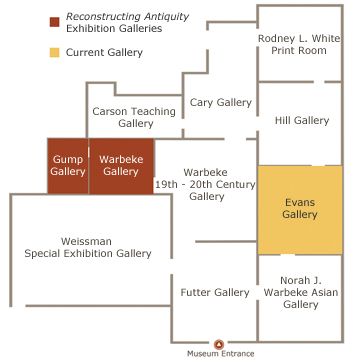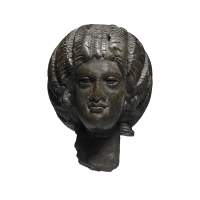Head of a woman with hairstyle of Empress Julia Domna
144.
Miniature carved head
Roman
Head of a woman with hairstyle of Empress Julia Domna
Ivory,
3rd century CE
Gift of Thomas T. Solley, B.A. 1950
Photograph courtesy of the Yale University Art Gallery
2002.15.1
Learn more about the object below
What a Doll
Label credits and suggested readings
Related Resources
Museum Floorplan
What a Doll
This tiny ivory head with delicately carved, lidded eyes and bow-shaped lips wears the fashionable coiffeur of the third-century Roman empress Julia Domna. She is not a portrait, however, but an example of the popular imagery that grew out of the Empress’ unique style. The head once connected to a long, loosely-jointed body—a doll that was fingered and gripped by a Roman girl whom she ultimately accompanied to the grave. With fully developed hips and breasts and an imperial crown of hair, the miniature woman served as a role model for the child to emulate and animate in life and in death.
Label credits and suggested readings
Label text by Bettina Bergmann, Helene Phillips Herzig '49 Professor of Art
Suggested readings:
Kate McK Elderkin, “Jointed Dolls in Antiquity,” American Journal of Archaeology, 34.4, 1930
(455-79).
Eve D’Ambra, “Child’s Play: Beauty for Roman Girls,” Woman as Subject and Object, ed. Sirir
Sande and Turid Karlsen Seim, Acta ad Archaeologiam et Artium Historiam Pertinentia, 22.8
2009 (15-36).
Maria Grazia Maioli, “Le vota delle donne e I giochi dei bambini, le alre facce dell’otium,”
Otium. L’arte di vivere nell domus romane di età imperiale, ed. Carlo Bertelli, Luigi Malnati,
Giovanna Montevecchi, Milan, 2008 (57-62).
Rudolf Degen, “Römische Puppen aus Octodurus/Martigny VS. Gliedergruppen der römischen
Antike,” Helvetica Archaeologica 28, 1997 (15-38).
Related Resources
Ancient images of women are remarkable for their ambiguity. Sometimes, identification is straightforward: on the Gerasa mosaics at left, Erato, muse of lyric poetry, is easily recognized by her lyre and name...
Museum Floorplan



